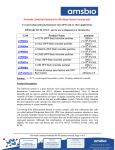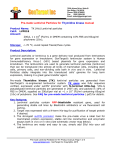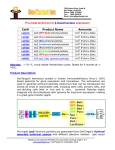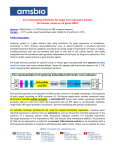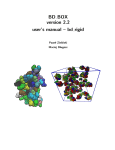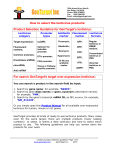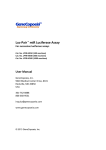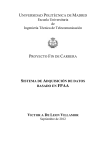Download GenTarget`s EcoTMPlasmid DNA Miniprep Kit User Manual
Transcript
Premade Lentiviral Particles for iPS Stem Factors (human set) For generating induced pluripotent stem (iPS) cells or other applications. RESEARCH USE ONLY, not for use in diagnostics or therapeutics Cat# Product Name h OCT4 (RFP-Bsd) inducible particles LVP003 h SOX2 (RFP-Bsd) inducible particles LVP004 h NANOG (RFP-Bsd) inducible particles LVP005 h LIN28 (RFP-Bsd) inducible particles LVP006 h cMyc (RFP-Bsd) inducible particles LVP007 h Klf4 (RFP-Bsd) inducible particles LVP008 LVP-stems-h Full set (6 human stem factors-with RFPBsd marker) amounts 200ul x (1 x108 IFU/ml) 200ul x (1 x108 IFU/ml) 200ul x (1 x108 IFU/ml) 200ul x (1 x108 IFU/ml) 200ul x (1 x108 IFU/ml) 200ul x (1 x108 IFU/ml) 200ul/ea x 6 Storage: < -70 °C, avoid repeat freeze/thaw cycles. Products stable for 6 month. Product Description: The lentiviral system is a gene delivery tool using lentivectors for gene expression or knockdown. Lentivectors are HIV-1 (Human Immunodeficiency Virus 1) derived plasmids and are used to generate lentiviral particles (lentivirus) that can be transduced virtually all kinds of mammalian cell types or organs, including stem cells, primary cells and non-dividing cells both in vivo and in cell culture system. Particles stably integrate into the transduced cells’ genome for long term expression. Therefore, lentivirus holds a unique promise as a gene transfer agent. Converting fully differentiated human or mouse somatic cells into embryonic-like cells (so called induced Pluripotent Stem Cell: iPSC) has attracted enormous attention in stem cell research. Multiple reports have demonstrated that iPS cells were generated by using a set of transcription factors or stem cell factors that can be delivered as expression virus or expressed proteins. Although the combination of reprogramming factors may vary slightly, the main stem cell factors are: OCT3/4, SOX2, NANOG, LIN28, cMyc and KLF4. Pre-made Lentiviral Particles for iPS product manual, Page 1 of 6 AMSBIO’s pre-made lentivirial particles for iPSC are generated from its proprietary lentiviral vector system with either RFP-Bsd fusion dual marker or Neomycin marker (No RFP) (see vector map scheme below). Six human stem cell factors were first individually cloned into lentivector. Then, lentivectors were co-transfected with a packaging mix (Cat# HT-pack) into a 293T packaging cells (cat# TLV-C). The premade lentiviral particles are VSV-G pseudotyped virus, packaged in serum-free medium, and supplied as 200ul/per vial at ~ 1x 108 IFU/ml. schematic representation of inducible lentivector Rsv RFP-Bsd or Neo WPRE (SIN) Inducible suCMV 3’LTR cppt RRE 5LTR Ψ Stem Factors: Oct3/ SOX2/ NANOG/ LIN28/c-Myc or KLF4 Each stem factor was natively expressed (without any tags) under a tetracycline inducible suCMV promoter in which two tetracycline operator sequences was integrated. The particles can be used for regular constitutive high expression. The same particles can also be used for tetracycline induced expression when the tetracycline regulator protein (tetR) is present in advance. For inducible expression, the tetR must be expressed in advance to stop the transcription, and expression is then activated by adding tetracycline. This inducible expression is dose dependent. In general, the amount of tetracycline used is 1ug/ml final concentration. Please see the schematic below for the mechanism of inducible expression, and see our website for more details about Inducible lentiviral system. For particles general information, please refer to FAQ about premade lentiviral particles. All six stem factor were sequencing verified. Their sequences fully match the CD region according to the NCBI’s database (see table below). Lentiviral particles contain blasticidin-RFP fusion marker, which allows selection of the transduced cells by either fluorescence sorting or antibiotic selection. Pre-made Lentiviral Particles for iPS product manual, Page 2 of 6 suCMV Tet operator gene tetR protein tet Expression particles Expression repressed 1. tetR protein binds to tetoperator sequences in promoter to repress the transcription. Add tet ( ) Expression induced 2. Tetracycline binds to tetR to release tetR from promoter, and transcription is initiated. How tetracycline induction works Target h Myc h Klf4 h Oct3/4 h SOX2 h LIN28 h NANOG NCBI ID Matched ORF position NM_002467 526-1890 NM_004235 595-2034 NM_002701 55-1137 NM_003106 428-1381 NM_024674 115-744 NM_024865 217-1134 Experimental Protocols for generating iPS cells (for your reference only): (Note: for the purpose other than generating iPS cells, please follow our web-link: general transduction protocols under premade lentiviral particles) 1. Seed the desired parent cells at 1×105 cells/well in a 24-well plate and incubated overnight; 2. Add 50ul of each lentivirial particle for iPSC (Oct3/4, Sox2, NANOG, LIN28, c-Myc and Klf4) (Note: Polybrene has been reported to enhance virus transduction at 6-8ug/ml final concentration. But Polybrene could be toxic to some cell types, so add as desired.) Notes: You can set up your own factor combinations dependent upon your cell type). Pre-made Lentiviral Particles for iPS product manual, Page 3 of 6 3. 4. 5. 6. 7. 8. Optional: to check the transduction ability of your cells, add 50ul of GFP(His) Control Lentiviral particles (LVP002) into cells. Check the expression level by GFP signal and transduction efficiency by RFP signal under a fluorescent microscope. Change to complete medium at 12hrs or at a longer time point after transduction (please aware that longer transduction times can result in more cell death when Klf4, SOX2 and cMyc are over-expressed), and incubated again overnight. Note: use the serum-free particles without any worry of unwanted differentiation) Check cell viability: you may observe some cells dying (floating up). From now on change the medium every two days (serum-free medium) Check transduction efficiency at 72 hours by vitalizing the RFP signal under a fluorescent microscope using a RFP filter (filer: Ex~550 / Em620nm). You may observe that the majority of cells are dead, but there will be some living cells showing a good RFP signal. At days 8~10, split the transduced live cells into feeder cells using your defined medium, continue to incubate for 24~48hrs. Change to hES medium, continue to incubate and change the hES medium every day; At days 13 ~ 18: you will observe the cells morphology changing and ES like colonies forming (see sample image below). iPSC generating from human fibroblast cells RFP filter (495nm/620nm) Bright light Pre-made Lentiviral Particles for iPS product manual, Page 4 of 6 iPS cell generated by AMSBIO’s iPS lentiviral particles: Safety Precaution: Please use extra caution when using lentiviral particles. Remember. Wear gloves at all the times when handling Lentiviral particles! Please note that although our lentiviral vectors contain all necessary bio-safety features, work with lentiviruses should be carried out under Biological Safety Level 2 (BL-2) or higher. Please conduct a thorough risk assessment for your project and contact your health and safety facilities for local guidelines and regulations. Please refer CDC and NIH’s links (see references) for more details regarding safety issues. Pre-made Lentiviral Particles for iPS product manual, Page 5 of 6 Related Product Premade lentiviral particle for six mouse stem factors: Cat#: LVP003m, LVP004m, LVP005m, LPV006m, LVP007m, LVP008m, and LVPstems-m h Oct3/4 stable cells 2 x 106 cells SC015 h LIN28 stable cells 2 x 106 cells SC016 h NANOG stable cells 2 x 106 cells SC017 References: 1. 2. 3. 4. 5. 6. NIH stem cell training program (Link). Masaki Ieda, Ji-Dong Fu, et al. (2010). Direct Reprogramming of Fibroblasts into Functional Cardiomyocytes by Defined Factors. Cell 142, 375-386. Takahashi, K. and Yamanaka, S. (2006). Induction of pluripotent stem cells from mouse embryonic and adult fibroblast cultures by defined factors. Cell 126, 663-676. Yu, J., Vodyanik, M.A., Smuga-Otto, K., Antosiewicz-Bourget, J., Frane, J.L., Tian, S., Nie, J., Jonsdottir, G.A., Ruotti, V., Stewart, R., Slukvin, I.I., and Thomson, J.A. (2007). Induced pluripotent stem cell lines derived from human somatic cells. Science 318, 1917-1920. Park, I.H., et al., Reprogramming of human somatic cells to pluripotency with defined factors. Nature, 2008. 451(7175): p. 141-6. Shao, L., et al., Generation of iPS cells using defined factors linked via the self-cleaving 2A sequences in a single open reading frame. Cell Res., 2009. 19(3): p. 296-306. 7. NIH Guidelines for Biosafety Considerations for Research with Lentiviral Vectors. (Link). 8. CDC guidelines for Lab Biosafety levels (Link). Pre-made Lentiviral Particles for iPS product manual, Page 6 of 6






